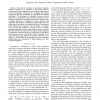Free Online Productivity Tools
i2Speak
i2Symbol
i2OCR
iTex2Img
iWeb2Print
iWeb2Shot
i2Type
iPdf2Split
iPdf2Merge
i2Bopomofo
i2Arabic
i2Style
i2Image
i2PDF
iLatex2Rtf
Sci2ools
CEC
2009
IEEE
2009
IEEE
Conformity and network effects in the Prisoner's Dilemma
— We study the evolution of cooperation using the Prisoner’s Dilemma as a metaphor of the tensions between cooperators and non-cooperators, and evolutionary game theory as the mathematical framework for modeling the cultural evolutionary dynamics of imitation in a population of unrelated individuals. We investigate the interplay between network reciprocity (a mechanism that promotes cooperation in the Prisoner’s Dilemma by restricting interactions to adjacent sites in spatial structures or neighbors in social networks) and conformity (the tendency of imitating common behaviors). We confirm previous results on the improved levels of cooperation when both network reciprocity and conformity are present in the model and evolution is carried on top of degreehomogeneous graphs, such as rings and grids. However, we also find that scale-free networks are no longer powerful amplifiers of cooperation when fair amounts of conformity are introduced in the imitation rules of the players. S...
| Added | 21 Jul 2010 |
| Updated | 21 Jul 2010 |
| Type | Conference |
| Year | 2009 |
| Where | CEC |
| Authors | José María Peña, Enea Pestelacci, Marco Tomassini, Henri Volken |
Comments (0)

